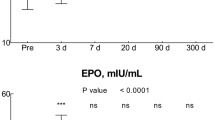Summary
A simplified model is described to estimate the oxygen delivery to tissues as a function of oxygen uptake, gas exchange ratio, 2,3-DPG/Hb concentration ratio, arterial and venous PO2, PCO2 and pH. Due to the complexity of the oxygen delivery system, the aim of this model is to predict relative changes of the oxygen delivery to tissues induced by changes of the other variables, rather than to yield absolute values. In this work, the importance of the observed shifts of the hemoglobin oxygen equilibrium curve at altitude is evaluated in terms of the efficiency of the oxygen transport system. it will be shown that a rightward shift of the oxygen equilibrium curve is beneficial up to 5400 m.a.s.l., while for higher altitudes such shifts lead toless efficient oxygen delivery to tissues.
Similar content being viewed by others
References
Adair GS: The hemoglobin system. VI. The oxygen dissociation curve of hemoglobin. J Biol Chem 63: 529–545, 1925.
Benesch R, Benesch RE: The effect of organic phosphates from human erythrocyte on the allosteric properties of human hemoglobin. Biochem Biophys Res Comm 26: 659–667, 1967.
Cerretelli P: Limiting factors to oxygen transport on Mount Everest. J Appl Physiol 40: 658–667, 1976.
Jorfeldt L, Wahren J: Leg blood flow during exercise in man. Clin Sci 41: 459–473, 1971.
Roughton FJM, Severinghaus JW: Accurate determination of oxygen dissociation curve of human blood above 98.7% saturation with data on oxygen solubility in unmodified human blood from 0 to 37 C. J Appl Physiol 35: 861–869, 1973.
Samaja M, Veicsteinas A, Cerretelli P: Oxygen affinity of blood in altitude Sherpas. J Appl Physiol 47: 337–341, 1979.
Samaja M, Winslow RM: The separate effects of H+ and 2,3-DPG on the oxygen equilibrium curve of human blood. Br J Hematol 41: 373–381, 1979.
Severinghaus JW: Carbon dioxide solubility and first dissociation constant (pK′) of carbonic acid in plasma and cerebrospinal fluid: man. In: Altman PL, Dittmer DS (eds) Respiration and circulation, Fed. Am. Soc. Exptl. Biol., Bethesda, Md, 1971, pp 218–219.
Thomas LJ: Algorithms for selected blood acid-base and blood gas calculations. J Appl Physiol 33: 154–158, 1972.
West JB, Boyer SJ, Graber DJ, Hackett PH, Maret KH, Milledge JS, Peters RM, Pizzo CJ, Samaja M, Sarnquist FH, Schoene RB, Winslow RM: Maximal exercise at extreme altitudes on Mount Everest. J. Appl. Physiol. 56: 688–698, 1983a.
West JB, Lahiri S, Maret KH, Peters RM, Pizzo CJ: Barometric pressure at extreme altitudes on Mount Everest: physiological significance. J Appl Physiol 54: 1188–1194, 1983b.
Winslow RM, Samaja M, West JB: Red cell function at extreme altitude on Mount Everest. J. Appl. Physiol. 56: 109–116, 1984.
Winslow RM, Samaja M, Winslow NJ, Rossi-Bernardi L, Shrager RI: Simulation of continuous blood oxygen equilibrium curve over physiological pH, DPG, and PCO2 range. J Appl Physiol 54: 524–529, 1983.
Author information
Authors and Affiliations
Rights and permissions
About this article
Cite this article
Samaja, M., diPrampero, P.E. & Cerretelli, P. Simulation of oxygen delivery to tissues: The role of the hemoglobin oxygen equilibrium curve at altitude. J Clin Monit Comput 2, 95–99 (1985). https://doi.org/10.1007/BF02916237
Issue Date:
DOI: https://doi.org/10.1007/BF02916237




